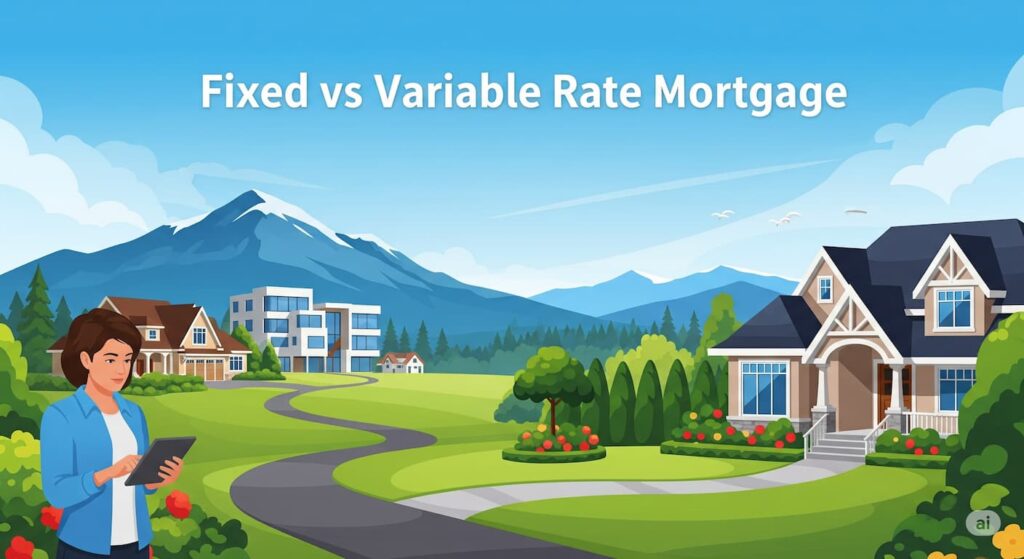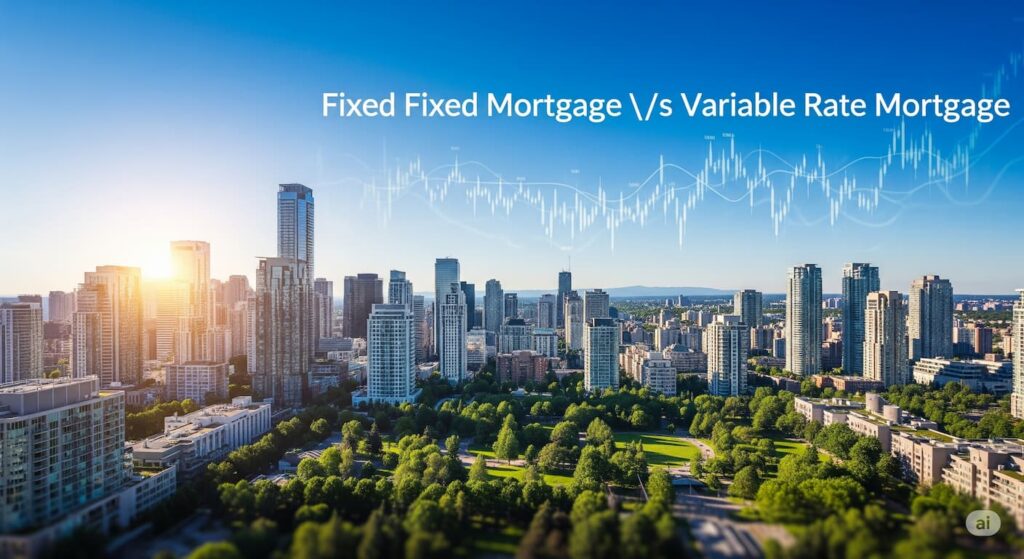- Intro: Choosing the Right Mortgage in Canada—Why It Matters Now More Than Ever
- 1. Understanding Canadian Mortgages: Fixed vs. Variable Explained
- 2. How Fixed Rate Mortgages Work in Canada
- 3. How Variable Rate Mortgages Work (And When They’re Worth It)
- 4. Key Differences Between Fixed and Variable Mortgages in Canada
- 5. When to Choose a Fixed Rate Mortgage in Canada
- 6. When a Variable Rate Mortgage Might Save You More
- 7. How the Bank of Canada Impacts Mortgage Rates
- 8. Fixed vs. Variable: Cost Comparison Over Time
- 9. Should You Switch Mortgage Types? Pros, Penalties & Timing
- 10. Tips to Choose the Right Mortgage for You in 2025 and Beyond
- 11. FAQs, Mortgage Resources, and Related Posts
- Thanks for Reading!
Intro: Choosing the Right Mortgage in Canada—Why It Matters Now More Than Ever
Buying a home is a big decision—but choosing the right mortgage might be even bigger. In today’s unpredictable interest rate climate, many Canadians are asking the same question:
“Should I go with a fixed rate or a variable rate mortgage?”
If you’re a first-time homebuyer, a current homeowner thinking about refinancing, or just trying to make sense of mortgage news, this guide is for you.
We’ll walk you through:
- How fixed and variable rate mortgages actually work
- What each type means for your monthly payments and long-term savings
- How interest rates, inflation, and the Bank of Canada shape the market
- When switching between mortgage types might make sense
- Plus, helpful comparisons, real-life examples, and common-sense tips
No jargon. No sales pitch. Just clear, practical advice tailored for anyone buying or borrowing in Canada—especially in 2025’s evolving financial landscape.
Let’s break it all down so you can feel confident in your choice.

1. Understanding Canadian Mortgages: Fixed vs. Variable Explained
Before we dive into comparisons, let’s get crystal clear on what “fixed” and “variable” mortgage rates actually mean in the Canadian context.
What Is a Fixed Rate Mortgage in Canada?
A fixed rate mortgage means your interest rate stays the same for the entire term of your mortgage—whether that’s 1, 3, 5, or even 10 years. Your monthly payment is predictable, and you won’t be affected by changes in the Bank of Canada’s overnight rate.
Why it matters:
- You know exactly how much you’ll pay every month
- Great for budgeting and financial planning
- Offers peace of mind, especially when rates are rising
Example: If you lock in at 4.5% for a 5-year fixed mortgage, that rate won’t change—even if national rates jump to 6% during your term.
What Is a Variable Rate Mortgage in Canada?
A variable rate mortgage means your interest rate can go up or down over time—typically tied to the lender’s prime rate, which follows changes by the Bank of Canada.
There are two main types:
- Adjustable-rate mortgage (ARM) – Your monthly payments change as the interest rate moves
- Variable with fixed payment – The payment amount stays the same, but how much goes toward principal vs. interest changes
Why some choose it:
- Historically lower initial interest rates
- Potential to save if interest rates drop
- Flexible for short-term ownership or early payoffs
Example: If your rate starts at 5.0% but the Bank of Canada cuts rates, your mortgage rate might drop to 4.5%, saving you money.
Why This Choice Is So Important
Choosing between fixed and variable affects:
- How much interest you pay over time
- Your financial stress level during market changes
- Your flexibility if you plan to move, refinance, or pay off early
Now that you understand the basics, let’s explore how fixed rate mortgages work—and when they’re the better choice.
2. How Fixed Rate Mortgages Work in Canada
If you’re someone who values stability and predictability, the fixed rate mortgage might feel like a safe harbour—especially in today’s changing economy. Let’s unpack how it works, what you get, and why it appeals to many Canadian homeowners.
What Is a Fixed Rate Mortgage?
A fixed rate mortgage means your interest rate is locked in for the entire term. No surprises, no adjustments—just consistent monthly payments.
Common fixed terms in Canada include:
- 1-year
- 3-year
- 5-year (most popular)
- 7- or 10-year options for long-term stability
Your mortgage term is not the same as your amortization period (usually 25–30 years). You renew the rate after each term ends.
Key Benefits of a Fixed Rate Mortgage
- Payment Predictability
You always know your monthly payment—ideal for budgeting. - Protection From Rising Interest Rates
If rates climb during your term, your payment stays the same. - Peace of Mind
Especially helpful for first-time homebuyers or families with tight cash flow.
Example: What Fixed Payments Look Like
Let’s say you borrow $500,000 over a 25-year amortization.
| Rate | Term | Monthly Payment (Approx.) |
| 4.99% fixed | 5 years | $2,908/month |
| If rates rise to 6.5% during your term | You still pay | $2,908/month |
That’s the power of a fixed mortgage: your rate doesn’t change, even when the market does.
Are There Downsides?
While fixed rates offer security, they also come with trade-offs:
- Higher initial rates than variable (most of the time)
- Big penalties if you break your mortgage early (especially with major banks)
- Less flexibility if interest rates fall during your term
Who Should Consider a Fixed Rate?
- First-time homebuyers who want financial stability
- Families with tight budgets or consistent income
- Borrowers concerned about rising interest rates
- Anyone planning to stay in their home for the entire term
3. How Variable Rate Mortgages Work (And When They’re Worth It)
If you’re comfortable with a bit of market movement and like the idea of potentially saving money, a variable rate mortgage might be the right fit. But how does it actually work—and what are the real risks?
Let’s break it down.
What Is a Variable Rate Mortgage in Canada?
A variable rate mortgage is tied to your lender’s prime rate, which moves based on the Bank of Canada’s policy interest rate. When rates fall, your mortgage interest rate typically goes down. When they rise, your rate (and possibly your payments) goes up.
There are two main types:
| Type | Monthly Payment | What Changes |
| Adjustable-Rate Mortgage (ARM) | Changes as rate changes | Payment amount shifts |
| Variable Rate with Fixed Payments | Stays the same | Amount of interest vs. principal varies |
Tip: Most Canadian lenders offer variable with fixed payments, which helps with budgeting but can lead to “negative amortization” if rates rise too much.
Key Benefits of Variable Rate Mortgages
- Lower Starting Rates
Historically, variable rates start 0.50%–1.00% lower than fixed. - Potential Interest Savings
If rates stay low or drop, you could pay less overall across the term. - More Flexible Exit Terms
Variable mortgages often have lower penalties if you switch or refinance early.
Real-World Example: Comparing Fixed vs. Variable
| Scenario | 5-Year Fixed @ 5.25% | 5-Year Variable @ Prime – 1.00% (e.g., 5.95% – 1.00%) = 4.95% |
| Starting Monthly Payment | $2,983 | $2,866 |
| Total Interest (5 years)* | $165,000 | ~$157,000 |
| If Rates Rise by 1.0% | No change | Payment increases to ~$3,047 |
*Example assumes $500,000 loan, 25-year amortization. These are estimates for illustration.
Risks of a Variable Rate
- Rising rates = rising payments or more interest
- Harder to budget or plan long-term
- If rates rise fast, you could hit your lender’s “trigger rate” (where your payment doesn’t cover interest)
Who Should Consider a Variable Rate Mortgage?
- Borrowers with high financial flexibility
- People who plan to sell or refinance before their term ends
- Those who expect interest rates to fall or remain stable
- Investors with short-term property goals
4. Key Differences Between Fixed and Variable Mortgages in Canada
By now, you understand the basics—but what really sets fixed and variable mortgages apart when it comes to real-world decision-making?
This section breaks it down so you can compare them side-by-side based on your priorities: payment stability, risk, flexibility, and cost savings.
Fixed vs. Variable: Side-by-Side Comparison
| Feature | Fixed Rate Mortgage | Variable Rate Mortgage |
| Interest Rate Stability | Stays the same for your full term | Fluctuates with prime rate (set by Bank of Canada) |
| Monthly Payment Predictability | Fully predictable and consistent | Can vary (unless fixed-payment variable plan) |
| Starting Interest Rate | Generally higher | Usually lower (by 0.5–1.0%) |
| Potential to Save on Interest | Limited—locked in even if rates fall | High—especially if rates drop or stay low |
| Early Break Penalty | Often higher (especially with banks) | Typically lower and easier to manage |
| Best For | Budget-conscious buyers, long-term planners | Flexible buyers, short-term holders, investors |
| Stress Test Consideration | Tested at contract rate + 2% | Also tested at contract rate + 2% (may affect qualification) |
| Refinancing Flexibility | Less flexible during the term | Easier to refinance or switch lenders |
What Does This Mean for You?
- Go Fixed if you want stability, are buying your “forever home,” or are risk-averse.
- Go Variable if you can handle some uncertainty, want potential savings, or plan to refinance/move within 3–5 years.
Rule of Thumb: If interest rates are expected to rise, fixed offers peace of mind. If they’re expected to fall or stay stable, variable may save you more.
Example Scenario: First-Time Buyer vs. Investor
| Buyer Profile | Ideal Choice | Why |
| First-Time Homebuyer | Fixed Rate Mortgage | Predictable payments, budgeting ease |
| Property Investor | Variable Rate Mortgage | Lower upfront costs, more flexibility |
5. When to Choose a Fixed Rate Mortgage in Canada
A fixed rate mortgage might not always be the cheapest option—but in certain situations, it’s clearly the smartest. Here’s when locking in your interest rate offers the most value and peace of mind.
1. When Interest Rates Are Expected to Rise
If economists or the Bank of Canada are signalling upcoming hikes, a fixed rate can help you lock in today’s lower rate before the market adjusts.
Example: In early 2022, rates were under 3%. By 2023, they jumped above 5%. Borrowers who locked in early saved thousands.
2. If You Have a Fixed Budget or Tight Cash Flow
Fixed payments make it easier to plan for the long term. If you:
- Rely on a steady monthly income
- Have kids or dependents
- Are close to retirement
…then budgeting consistency matters.
Fixed rates = no surprises, no sudden payment jumps.
3. When You Plan to Stay in Your Home for Several Years
Fixed rate mortgages offer the most benefit when you stay put through your full term (e.g. 5 years). It minimizes your exposure to prepayment penalties or rising rates during renewal.
Planning to live in your home for 5–10 years? A 5-year fixed is a popular and stable choice.
4. If You’re a First-Time Homebuyer
Buying your first home comes with enough uncertainty. A fixed rate helps you focus on settling in—without worrying about economic fluctuations or central bank policy changes.
Fixed Rate = Financial Security in Volatile Times
When inflation is high, the economy is unstable, or you’re just not comfortable with “what-ifs,” fixed rate loans offer a layer of protection that many homeowners value more than minor savings.
Tip: Not sure what rate environment we’re heading into? Ask your broker for a rate forecast or explore “hybrid” mortgages that combine fixed + variable options.
6. When a Variable Rate Mortgage Might Save You More
Despite market uncertainty, variable rate mortgages continue to attract savvy borrowers—especially those with short-term plans or a strong risk appetite. But when does this flexible option make real financial sense?
Let’s look at scenarios where a variable rate could put more money back in your pocket.
1. When Rates Are Expected to Fall or Stay Low
If you (or your mortgage advisor) believe the Bank of Canada will lower rates in the near future, a variable rate lets you benefit from those drops—while fixed-rate borrowers stay locked into higher rates.
Historical Note: From 2009–2017, Canadians with variable rates often paid less overall than those with fixed mortgages.
2. If You Plan to Sell or Refinance in the Next 2–3 Years
Variable mortgages generally come with lower break penalties—often just 3 months’ interest. This can save you thousands if:
- You move to a new home
- Refinance to access home equity
- Pay off your loan early
Fixed-rate break penalties can be much higher (especially with banks using the IRD method).
3. You Want Lower Monthly Payments—At Least to Start
Variable rates typically start lower than fixed ones. If you’re looking to maximize monthly cash flow early on, this can free up budget for:
- Renovations
- Investments
- Emergency savings
Tip: You can always prepay more while rates are low—paying down principal faster.
4. If You Have a Strong Financial Buffer
If you can tolerate a potential payment increase—and have savings to fall back on—a variable rate might make sense. This is especially true for:
- Dual-income households
- Investors
- Borrowers with low debt-to-income ratios
Stability matters, but flexibility can reward those who plan well.
Real-Life Example: Short-Term Investor Scenario
| Borrower | Real Estate Investor |
| Plan | Hold property for 2 years |
| Choice | Variable rate mortgage |
| Why? | Lower upfront rate + easy exit with minimal penalty |
7. How the Bank of Canada Impacts Mortgage Rates
Ever wonder why your mortgage rate suddenly changes—or why lenders keep talking about the Bank of Canada (BoC)? Whether you’re choosing a fixed or variable mortgage, understanding this central bank’s role is key to making a smart financial decision.
What Is the Bank of Canada, and Why Does It Matter?
The Bank of Canada is the country’s central bank, responsible for keeping the economy stable. One of its main tools is setting the overnight lending rate—the rate at which major banks borrow money from each other.
This base rate influences all kinds of interest rates across the country—including mortgages, credit cards, and loans.
How It Affects Variable Mortgage Rates
Variable rate mortgages are directly tied to your lender’s prime rate, which moves in lockstep with the Bank of Canada’s overnight rate.
| BoC Raises Rates | Your variable rate likely goes up |
| BoC Cuts Rates | Your variable rate likely goes down |
So, if the BoC raises its rate by 0.25%, your mortgage rate—and potentially your monthly payment—goes up by the same amount.
What About Fixed Rate Mortgages?
Fixed mortgage rates don’t follow the BoC rate directly. Instead, they’re influenced by bond yields, which are affected by:
- Inflation expectations
- Global economic trends
- Long-term interest rate forecasts
Still, fixed rates often move in anticipation of BoC decisions, especially if markets expect rate hikes or cuts.
Example: Impact of a 1.00% BoC Rate Hike
Let’s say you have a $500,000 mortgage on a variable rate of 5.50%, and the BoC raises rates by 1.00%.
- Your new rate: 6.50%
- Your monthly payment could rise by $280–$350/month, depending on your amortization and structure.
Why This Matters When Choosing Fixed vs. Variable
- If you believe the BoC will keep raising rates → Fixed offers protection
- If you think rates will stabilize or fall → Variable could save you money
8. Fixed vs. Variable: Cost Comparison Over Time
Understanding the difference between fixed and variable rate mortgages isn’t just about theory—it’s about how much it could cost (or save) you over time. Let’s look at a few real-world examples based on 2025 mortgage trends in Canada.
Example 1: 5-Year Term Mortgage – No Rate Changes
| Mortgage Type | Interest Rate | Monthly Payment | Total Interest Over 5 Years |
| Fixed | 5.25% | $2,983 | ~$167,000 |
| Variable | 4.75% | $2,845 | ~$159,000 |
In a stable rate environment, variable mortgages usually cost less, thanks to lower starting rates.
Example 2: 5-Year Term – With Rising Rates
Assume BoC increases rates by 1.00% over the next 24 months.
| Mortgage Type | Starting Rate | New Rate (Yr 3) | Impact |
| Fixed | 5.25% | 5.25% (unchanged) | No change to payment |
| Variable | 4.75% | 5.75% | Payment increases ~$200/month |
| Total Cost | ~Same | Variable likely costs more by Year 5 |
Variable can cost more if rates rise faster or higher than expected.
Example 3: 5-Year Term – With Falling Rates
Assume BoC cuts rates by 0.75% during the first 2 years.
| Mortgage Type | Rate Drops To | Total Savings vs. Fixed |
| Variable | 4.00% | ~$7,000–$9,000 over 5 years |
| Fixed | 5.25% | None |
In a falling rate environment, variable is clearly the winner—but only if you can ride out the ups and downs.
What These Comparisons Teach Us
- Fixed = Peace of mind (even if you pay a bit more)
- Variable = Flexibility and potential savings, but with some risk
- Your time horizon, risk comfort, and market outlook matter more than just the rate

9. Should You Switch Mortgage Types? Pros, Penalties & Timing
Life changes, markets shift—and what worked for you when you first signed your mortgage might not work today. Whether you’re on a variable rate and want to lock in, or stuck in a high fixed rate hoping to switch, here’s what to know before making a move.
Can You Switch from Variable to Fixed?
Yes. Most lenders in Canada allow you to lock in your variable rate to a fixed one during your term. This is called a “conversion”, and it’s typically:
- Penalty-free, but
- You must switch to a term that is equal to or longer than your remaining term
- The new rate is the lender’s posted fixed rate, not always their best offer
Useful if rates are rising and you want payment stability without breaking your mortgage.
Breaking a Fixed Mortgage: What It Costs
If you want to switch from fixed to variable, or refinance to a lower fixed rate, you’ll likely face a prepayment penalty.
How penalties are calculated:
- Variable rate mortgage: 3 months’ interest
- Fixed rate mortgage: Greater of 3 months’ interest or Interest Rate Differential (IRD)
IRD can be expensive—sometimes $10,000 or more—depending on your rate and time remaining.
When Does Switching Make Sense?
Consider switching when:
- Rates have dropped significantly and your penalty is less than the interest savings
- Your life plans have changed (e.g. selling your home, upsizing)
- You’re nearing mortgage renewal and want a better rate or term
Real Example: Break or Stay?
| Scenario | Fixed Rate | Variable Rate |
| Time left on term | 3 years | 3 years |
| Current rate | 5.75% | 6.00% |
| Market rate now (fixed/var.) | 4.79% / 5.25% | 4.95% |
| Estimated penalty | $8,500 (fixed) | $3,000 (variable) |
| Break-even period | ~2 years | ~1 year |
Quick Tips Before You Switch
- Ask your lender for a penalty estimate in writing
- Compare offers from other lenders before committing
- Consider blend-and-extend options if you want lower payments without a full break
- Always factor in legal fees, appraisal costs, and closing timelines
10. Tips to Choose the Right Mortgage for You in 2025 and Beyond
There’s no one-size-fits-all mortgage—and that’s exactly why getting the right fit for your financial life matters. Whether you’re buying your first home, renewing an existing mortgage, or investing in property, here are smart, experience-based tips to guide your decision.
1. Know Your Financial Personality
Ask yourself:
- Do I lose sleep over rate changes? → Fixed might be better.
- Am I okay riding market waves to save long-term? → Variable could be a win.
- Do I need payment certainty for budgeting? → Go fixed.
- Do I have emergency savings or backup income? → Variable may work.
2. Match Your Mortgage to Your Timeline
| Timeframe | Suggested Rate Type |
| Living in home 5+ yrs | Fixed rate for stability |
| Moving/refinancing <3 yrs | Variable for flexibility |
| Unsure of future plans | Consider short-term fixed (1–3 yrs) or hybrid |
The shorter your stay, the more important flexibility and lower penalties become.
3. Ask About Discounts and Special Offers
Many lenders offer:
- Rate discounts on fixed or variable options
- Cashback mortgages for closing costs
- Blend-and-extend options at renewal time
Always negotiate or compare offers—even between big banks and credit unions.
4. Stay Informed About Market Conditions
Follow:
- Bank of Canada rate announcements (8x/year)
- Inflation and housing news
- Industry commentary from mortgage brokers
Being proactive helps you renew, refinance, or switch at the right time—not when it’s too late.
5. Use Tools to Simulate Your Payments
Before you sign:
- Use a mortgage affordability calculator
- Try a fixed vs. variable comparison tool
- Estimate your penalty costs if you might break early
Final Word: Make the Decision That Works for You
Don’t choose based on trends or headlines—choose based on your goals, income, and tolerance for risk.
Still undecided? Talk to a licensed mortgage broker who can:
- Compare lender offers
- Walk you through penalties and hidden terms
- Match you with the best mortgage structure for your future
11. FAQs, Mortgage Resources, and Related Posts
Before you go, here are some quick answers to common questions, plus trusted resources to help you make an informed mortgage decision in Canada.
Frequently Asked Questions
Q1. Is it better to go fixed or variable in 2025?
It depends on your financial stability and rate outlook. If rates are expected to rise, fixed provides certainty. If rates may fall or you plan to move soon, variable could save you money.
Q2. Can I switch from variable to fixed mid-term?
Yes, many lenders allow you to convert from variable to fixed without penalty—though you’ll likely switch to a posted rate.
Q3. Are mortgage penalties tax-deductible in Canada?
Usually not for primary residences, but consult a tax professional if you’re refinancing investment property.
Q4. How often does the Bank of Canada change rates?
The BoC typically reviews rates eight times a year. These updates directly impact variable rate mortgages.
Q5. Should I get a mortgage through a bank or a broker?
Mortgage brokers can often access more competitive rates and offer more flexibility, especially for unique borrower profiles.
Helpful Tools & Government Resources
- CMHC – Canada Mortgage and Housing Corporation
- Bank of Canada Key Interest Rates
- Mortgage Qualifier Tool – Government of Canada
Thanks for Reading!
Whether you choose fixed or variable, your mortgage decision should match your financial goals, lifestyle, and tolerance for risk. We hope this guide helped you feel confident, informed, and prepared.
Feel free to share this article or bookmark it for later—and don’t forget to subscribe for more friendly, finance-savvy insights!



